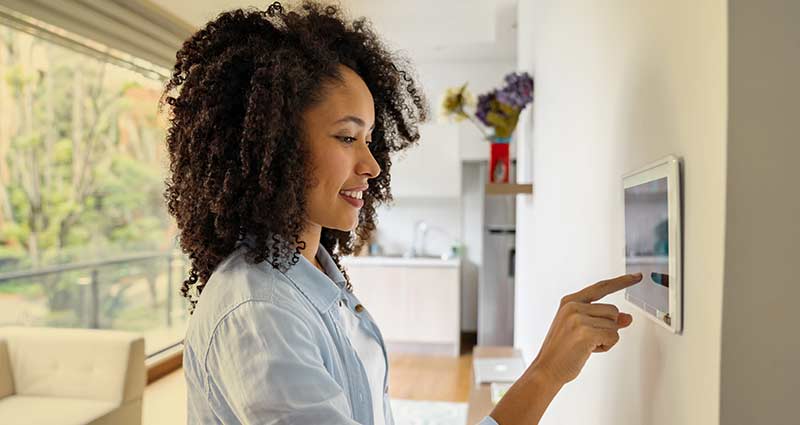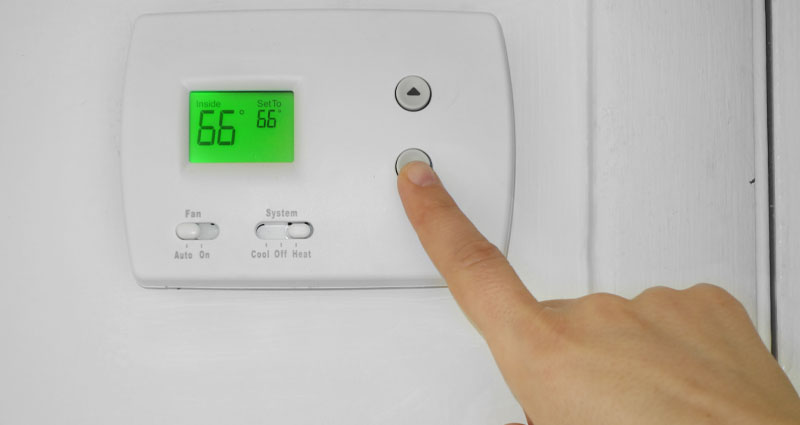The best temperature settings when you're at home
To stay comfortable and save money, the U.S. Department of Energy recommends the best AC setting during summer is 78°F (26°C) when you are home. Setting your air conditioner to this level will allow you to stay cool and avoid an unusually high electricity bill. If you still find yourself looking for relief, you can invest in a dehumidifier and follow our tips below to trap cool air in your home.
The best AC settings when you're away
Keeping your house warmer while you are away can help you save even more money this summer. Turning your thermostat up 7° to 10°F (2 to 3°C) higher while you are away at work, or any time you're out of the house for more than 2 hours, can help you save as much as 10% on cooling costs. So, to save money and energy while you're away in the summer, the best AC setting is 88°F (31°C). The higher interior temperature slows the flow of heat into your home, so it won't take as much energy to cool things back down as you think when you return home.
Tips to maximize cooling efforts in your home
Although 78°F might still sound uncomfortably high, you can help your air conditioner provide better cooling for less energy by preventing warm air from getting into your home and cool air from escaping. Follow these simple tips to keep your home cool and comfortable all summer long:
- Hang up window treatments that block sunlight and prevent heat from entering through your windows.
- Install fresh or replace old weatherstripping and caulk around doors and windows to keep your home sealed.
- Limit the use of appliances that generate heat, like the oven and stove, until after 8 p.m. In the summer, try to grill outside as much as possible.
- Install ceiling fans to increase cooling efficiency.
- Replace cooling units with energy-efficient models.
Finding the right temperature for your family
Try an experiment where you secretly set your AC to 81°F for a few hours and see how your family reacts. Over the next few days, drop the temperature 2°F until you reach 71°F. Then you can set your thermostat to what you find to be the average of your family's comfortable range. According to the American Society of Heating, Refrigerating and Air Conditioning Engineers (ASHRAE), the preferred temperature range for occupants dressed in summer clothes is 73°F to 79°F.
Nighttime is another opportunity for conservation. When you go to sleep, your core body temperature lowers and heat radiates from your extremities. A study found the best sleep happens as the body reaches "thermoneutrality" when environmental temperatures are at 86°F (nude and uncovered) or 60 to 66°F (wearing pajamas and covered by a sheet). This suggests one tactic to help enjoy a good night's sleep during the summer is to raise your AC to a warmer setting, say 80°F while using lighter bedding and sleepwear.
But even if you decide it's worth the dollars to keep your home a few degrees frostier, at least you can make an informed choice about how you spend your money. The really good news is you can take other steps to try to squeeze out those savings without making yourself miserable for the summer.
Keep an eye on the humidity
High humidity can turn a garden-variety hot day into something much more challenging to endure because your body's sweat glands don't work as efficiently when there's a lot of moisture in the air. Sweat works to maintain body temperature by evaporating from your skin and carrying away body heat. When the air is dry, your sweat dissipates readily and you feel more comfortable. However, as humidity rises, the increased water vapor in the air makes it more and more difficult for your sweat to evaporate, leaving you even hotter even while you're drenched in moisture.
As an example, an 80°F day feels like 80°F when the relative humidity is 40%, but an 80°F day with 90% humidity has a "heat index" of 86°F, which means you need to take extra steps to cool down. Fortunately, air conditioners are extremely good at reducing relative humidity, especially if your home is air-sealed and has vapor barriers in the basement or crawlspaces.
If you're counting on your AC to tackle the humidity, make sure your unit isn't too big for your home, because the system will only need to run for a short time to cool the house, and won't be on long enough to dehumidify. The EPA recommends an ideal humidity level of 30 to 50% during the summer to prevent mold and pests, which will also keep you more comfortable during the heat of summer. A dehumidifier can help you achieve lower humidity if you want to save your air conditioner some of the burden.
What's more, you can supplement your air conditioner with personal fans and ceiling fans, which blow air across your body to aid evaporation. While fans don't lower the temperature of a room, they make it feel cooler by taking a bite out of the humidity.
The importance of a programmable thermostat
Although raising your thermostat's temperature while away can mean serious savings, few people remember to change the temperature settings every time they enter and leave the house. Fortunately, a smart or programmable thermostat can do that job for you, ensuring that you live in a comfortable setting while saving you money. Programmable thermostats allow you to set different temperatures based on factors like the time of day, when you're home and when the house is empty.
You can set your AC to begin cooling down your home 30 minutes before you arrive, ensuring your interior is at a comfortable temperature when you step inside. Smart thermostats also allow you to control the temperature via your smartphone or tablet, and they can observe when you enter or leave the house and automatically adjust the settings accordingly. They can even help control humidity levels, as many programmable thermostats will display the relative humidity at the push of a button.
Have you followed our recommended thermostat settings and other energy savings tips but still see an abnormally high bill? Read our guide on why your electricity bill may increase in the summer. And for the colder months, we’ve outlined the best temperature to set your thermostat in the winter, as well.
Staying comfortable while keeping utility costs reasonable in the summer is tricky, but it's not impossible. Sign up for an electricity plan with Direct Energy and you'll get the tools you need to track your usage and stay energy-efficient.



































